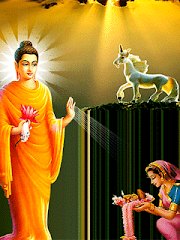

| 14. Towards human dignity. Sunita was a scavenger born into a so called outcaste community. On meeting the Buddha on his almsround one day, the humble youth prostrated himself before the Master in adoration. Asking for ordination he is taken to the temple where he soon becomes worthy of the highest obeisance of both deva and brahma gods. Thus the Buddha teaches that a man becomes neither a Brahmin nor a low-caste by birth, but by deeds alone. |

| 13. Freedom of thought. At times referred to as the Buddha's Charter of Free inquiry this discourse was given by the Buddha to the Brahmin Kalamas at Kesaputta. 2500 years ago, preaching against blind belief in Buddha gave prominence to and encouraged the spirit of free inquiry and independence of thought and action, subject to sound judgment. He trained his disciples in the art of questioning as well as in the finer points of debate and discussion. Pointing out the dangers of haphazard thinking the Buddha teaches the Kalamas the art of reasoning for the sole purpose of arriving at true understanding of the Buddha's teaching of the Four Noble Truths. |

| 12. Buddha teaches that all Phenomena is soulless. When a thing is impermanent, as all conditioned things are, and thus susceptible to change, there can be no overlord or Self. Helpless in arranging things according to its wishes there can be no soul as master over mind and body. The Buddha explains the soullessness of beings to the five bhikkhus at Isipatana in Benares, in the discourse on soullessness (Anattalakkana Sutta). |

| 11. Unsatisfactoriness of Life. According to the Buddha, whatever is impermanent is subject to suffering, and the world rests on this basic factor of suffering (Dukkha). However, having accepted this fact, He goes on to teach man how to gain his release from all suffering. The tragic story of Patacara who loss her whole family within a matter of a single day and night, points out only too well how suffering besets the unsuspecting worlding. After listening to the Buddha she gains peace and sanctity. |

| 10. The Philosophy of change. The Buddha teaches that all conditioned things are in a state of flux or change, and thus impermanent. The ever changing nature of both mind and matter proves the insubstantiality of life, and the instability of existence. Knowing this, Khema the consort of King Bimbisara avoided going to see the Buddha: for being very beautiful, she was afraid the Buddha would disparage her self-conscious awareness of her loveliness. As she went into his presence one day, the Buddha creates the illusion of a beautiful young woman before her, who gradually grows old before her very eyes and collapses at the feet of the Master. Alarmed and ashamed she realises the impermanence of the human body. |

|
| 9. The law of Causation or Dependent Arising. After His Enlightenment under the Bodhi-tree at Buddhagaya, the Buddha reflects on the law of Dependent Origination (Paticca Samuppada). He ponders as to how things come into being due to past and present conditions to cause suffering. Next He muses on the cessation of these very things when their cause has been removed. Then he reflects on both the arising and the cessation of all things conditioned and inter dependent, in the present, the past and the future. |

| 8. Go now and wander for the welfare of the many. The Buddha stays on at Isipatana for the rainy season. However, before that, within the first week of His giving of the Dhammacakkappavattna Sutta, all five ascetics reach the highest fruition of Sainthood and thus become the first five Arahant disciples of the Buddha. Before the rainy season is over fifty five others have followed suit. The Buddha now exports His sixty disciples: - 'Go forth ye bhikkhus, for the welfare of the many, for the happiness of the many, out of compassion for the world, for the good, welfare and happiness of gods and men'. Accordingly the disciples set forth to spread the new teaching. |
| 7. The First Discourse. Having realized the Four Noble Truths - the Noble Truth of Suffering; the Cause of Suffering; the Cessation of Suffering; and the Path leading to the Cessation of Suffering - by himself, the Buddha now decides to teach them to the five ascetics who had earlier served him at Uruvela, in Buddhagaya. At the end of this First Discourse, which is known as the "Dhammacakkappavattana Sutta" and given to the five ascetics who were now living at Isipatana in Benares, the oldest of them, Kondanna realises the first path and fruition of the Stream-winner (Sotapanna), or one who goes against the stream of Samsara (the recurring cycle of life and death). |


.gif)




ไม่มีความคิดเห็น:
แสดงความคิดเห็น